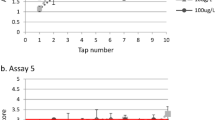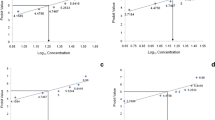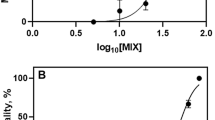Abstract
Semi-static acute toxicity tests were conducted on adult roach, Rutilus rutilus, to estimate its sensitivity toward an equitoxic binary mixture (EBM) of copper and nickel. The sum of their individual LC50 values was considered to equal 100 %. The main endpoints of the study were mortality and behavioral responses: detection, locomotor activity, coughing rate and pectoral-fin activity. The 96-h LC50 of EBM was 14.4 (10.1 %–20.5 %), indicating a synergism of individual metals. The most meaningful behavioral results were obtained after 10-min, 1-h and 24-h exposures, and the most sensitive and informative behavioral response was found to be coughing rate. This bioassay response may be used successfully to evaluate wastewaters containing heavy metals for their toxicity toward fish.
Similar content being viewed by others
References
Alabaster JS, Lloyd R (1982) Water quality criteria for freshwater fish. FAO and Butterworths, London
ASTM (2008a) Standard guide for measurement of behavior during fish toxicity tests. E1711-95(2008). ASTM International, West Conshohocken, PA
ASTM (2008b) Standard guide for ventilatory behavioral toxicology testing of freshwater fish. E1768-95(2008). ASTM International, West Conshohocken, PA
Atchison GJ, Henry MG, Sandheinrich MB (1987) Effects of metals on fish behavior: a review. Environ Biol Fish 18:11–25
De Boeck G, Vlaeminck A, Balm PH, Lock RA, De Wachter B, Blust R (2001) Morphological and metabolic changes in common carp, Cyprinus carpio, during short-term copper exposure: interactions between Cu2+ and plasma cortisol elevation. Environ Toxicol Chem 20:374–381
Drummond RA, Spoor WA, Olson GF (1973) Some short-term indicators of sublethal effects of copper on brook trout, Salvelinus fontinalis. J Fish Res Board Can 30:698–701
Eisler R. (1998a) Copper hazards to fish, wildlife and invertebrates: a synoptic review. Biological science report USGS/BRD/BSRN-1997-0002, Washington, DC
Eisler R (1998b) Nickel hazards to fish, wildlife and invertebrates: a synoptic review. Biological science report USGS/BRD/BSR-1998-0001, Laurel, MD
Ellgaard EG, Ashley SE, Langford AE, Harlin DC (1995) Kinetic analysis of the swimming behavior of the goldfish Carassius auratus exposed to nickel: hypoactivity induced by sublethal concentrations. Bull Environ Contam Toxicol 55:929–936
Flerov BA (1989) Ecological and physiological aspects of toxicology in fresh-water animals (in Russian). Nauka, Leningrad
Gagnon A, Jumarie C, Hontela A (2006) Effects of Cu on plasma cortisol and cortisol secretion by adrenocortical cells of rainbow trout Oncorhynchus mykiss. Aquat Toxicol 78:59–65
Hamilton MA, Russo RC, Thurston RV (1977) Trimmed Spearman-Karber method for estimating median lethal concentrations in toxicity bioassays. Environ Sci Technol 11:714–719
Henry MG, Atchison GJ (1986) Behavioral changes in social groups of bluegills exposed to copper. Trans Am Fish Soc 115:590–595
Kane AS, Salierno JD, Brewer SK (2005) Fish models in behavioral toxicology: automated techniques, updates and perspectives. In: Ostrander GK (ed) Methods in aquatic toxicology, 2nd edn. Lewis Publishers, Boca Raton, pp 559–590
Kazlauskienė N, Vosylienė MZ (1990) Effect of copper on respiratory system of rainbow trout (in Russian). In: Andrušaitis GP et al. (eds) Experimental aquatic toxicology, vol 14. Zinatne, Riga, pp 136–144
Könemann H (1981) Fish toxicity tests with mixtures of more than two chemicals: a proposal for a quantitative approach and experimental results. Toxicology 19:229–238
Lemly AD (1983) A simple activity quotient for detecting pollution-induced stress in fishes. Environ Tech Lett 4:173–178
Little EE, Finger SE (1990) Swimming behavior as an indicator of sublethal toxicity in fish. Environ Toxicol Chem 9:13–19
Scherer E (1992) Behavioural responses as indicators of environmental alterations: approaches, results, developments. J Appl Ichthyol 8:122–131
Scherer E, Harrison SE, Brown SB (1986) Locomotor activity and blood plasma parameters of acid-exposed lake whitefish Coregonus clupeaformis. Canadian J Fish Aquat Sci 43:1556–1561
SCORECARD (2005) Water quality indicators. http://www.scorecard.org
Svecevičius G (2005) Behavioral responses of rainbow trout Oncorhynchus mykiss to sublethal toxicity of a model mixture of heavy metals. Bull Environ Contam Toxicol 74:845–852
Svecevičius G (2010) Acute toxicity of nickel to five species of freshwater fish. Pol J Environ Stud 19:453–456
Svecevičius G, Vosylienė MZ (1996) Acute toxicity of copper to common fishes of Lithuania. Ekologija 2:17–21
Tudorache C, Jordan AD, Svendsen JC et al (2009) Pectoral fin beat frequency predicts oxygen consumption during spontaneous activity in a labriform swimming fish Embiotoca lateralis. Environ Biol Fish 84:121–127
US EPA (2002) Short-term methods for estimating the chronic toxicity of effluents and receiving waters to freshwater organisms. 4th edn. EPA-821-R-02-013. Office of Water. Washington, DC
US EPA (2006) National recommended water quality criteria. Office of Water. Office of Science and Technology (4304T). Washington, DC
US EPA (2007) Aquatic life ambient freshwater quality criteria—copper. 2007 Revision. EPA-822-R-07-001. Office of Water. Office of Science and Technology. Washington, DC
US EPA (1984) Ambient water quality criteria for copper—EPA-440/5-84-031. Office of Water Regulations and Standards, Washington, DC
USEPA (1986) Ambient water quality criteria for nickel—EPA-440/5-86-004. Office of Water Regulations and Standards, Washington, DC
Van der Schalie WH, Shedd TR, Knechtges PL, Widder MW (2001) Using higher organisms in biological early warning systems for real-time toxicity detection. Biosens Bioelectron 16:457–465
Waser W, Bausheva O, Nikinmaa M (2009) The copper-induced reduction of critical swimming speed in rainbow trout Oncorhynchus mykiss is not caused by changes in gill structure. Aquat Toxicol 94:77–79
Acknowledgments
This work was funded by Research Council of Lithuania, Project No. MIP-58/2010-2011.
Author information
Authors and Affiliations
Corresponding author
Rights and permissions
About this article
Cite this article
Svecevičius, G., Kazlauskienė, N. & Taujanskis, E. The Acute and Behavioral Effects of a Copper-Nickel Mixture on Roach Rutilus rutilus . Bull Environ Contam Toxicol 89, 147–151 (2012). https://doi.org/10.1007/s00128-012-0636-5
Received:
Accepted:
Published:
Issue Date:
DOI: https://doi.org/10.1007/s00128-012-0636-5




